Posts: 276
Threads: 2
Joined: Sep 2023
Country: 
10-18-2023, 11:13 PM
(This post was last modified: 10-18-2023, 11:25 PM by Kale.)
Howdy all,
Figured I'd dig in and do some work for my first thread on the new forum. Hopefully this stimulates some discussion.
I'd really like to hear the opinions of those more well versed in paleolithic archaeology than myself (so pretty much everyone).
The product of my endeavor is a rather monstrous qpgraph, including 24 populations...
Mbuti
ZlatyKun
Ust_Ishim
BachoKiro_IUP
China_UP (Tianyuan & AR33k)
Onge_Jarawa (modern Onge, modern Jarawa, and Andaman_100BP)
Jomon
RUS_Primorsky_N (DevilsCave & Boisman)
Goyet_Fournol (GoyetQ116_1 & FRL006)
Yana
MA1
Muierii1
Kostenki14
Sunghir
BachoKiro_BK1653
Gravettian (KremsWA, Vestonice, Paglicci, Ostuni)
Peru_RioUncallane_1800BP
Georgia_UP (NEO283 & Dzudzuana)
Italy_WHG (GrottaContinenza, AreneCandide, San Teodoro, Oriente, Grotta del Uzzo 5054)
Pinarbasi
IBM (Taforalt & Morocco_Epipaleolithic OUB002)
Iran_N (GanjDareh, Wezmeh, TepeAbdulHosein)
EHG (Arkhangelsk, Sidelkino, and the early Minino individuals)
CHG
Attached to this post you should find a zip file containing
- Graph.SVG, open that in your browser to view the graph
- Dotfile and edgelist for the qgraph
- A text document and excel sheet that both contain the same information regarding residual stats
- Normal.PNG, a plot showing the distribution of the residuals and testing that distribution for normality (it appears to pass, which coupled with the worst F3 residual being z = 2.01, supposes to me all affinities are adequately accounted for)
To try and summarize the important and/or unexpected takeaways...
The first X node represents Neanderthal ancestry (for BachoKiro_IUP) and Neanderthal and/or damage in BachoKiro_BK1653
ZlatyKun = branches in between basal Eurasians and crown Eurasians, a dead end or a direct ancestor of crown Eurasians?
Goyet_Fournol = a mix of Ust-Ishim and something occupying a similar position to BachoKiro_IUP
'Kostenki-cluster' = a mix of Goyet related ancestry and basal.
ANE = Kostenki-cluster + a generic sort of East-Eurasian (Yana has some Tianyuan on top)
East-Asians (Jomon/Primorsky) = Onge-related lineage + Tianyuan
Near-East = after mixing into the Kostenki-cluster, Basal becomes mixed with the Onge-related lineage that contributes to East-Asians
Georgia_UP = a mixture of the above BE/East-Asian mix and Muierii1
Pinbarbasi = Georgia_UP-like but with 10% WHG
Iran_N = baseline is BE/East-Asian mix, with some ANE and Pinarbasi
CHG = Iran_N but with more Pinarbasi and some EHG
Taforalt = a mix of ANA, proto-Pinarbasi (before the WHG), and 'Levantine Aurignacian', a Goyet-related population that presumably passed through SE Europe 'Balkan Arignacian?', and that also proves crucial in BK1653 and WHG. I do remember reading about a late surivial of Aurignacian technology in Greece, maybe that is related.
WHG = Gravettian + 'Balkan-Aurignacian' + Georgia_UP + ANE
EHG = WHG + Pinarbasi + para-Native-American (UKY, Kolyma, etc.)
Note that in especially the real early branching and in East Eurasians, where we have so few samples, there are multiple phylogenies that work, I just picked the one that made most sense to me.
The following 7 images attempt to illustrate on a map, and through time, what is happening on the graph. Black lines more or less represent regular branching and drift, red and blue lines indicate admixture sources, purple lines indicate the post-admix population. Green lines indicate drift not occuring over distance, but over time - a period of geographic standstill which drift occurred. The colors on the 15kbp slide don't mean much, I got tired and just drew arrows because there are 3 way mixes going on.
The 7 time periods are roughly, 1) pre-40k, 2) post-CI Eruption, 3) 35kbp, 4) 30kbp, 5) LGM-onset, 6) post-LGM, 7) 15kbp

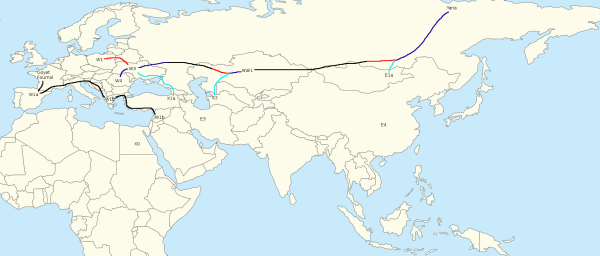
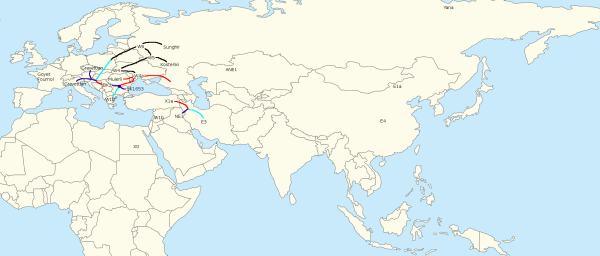
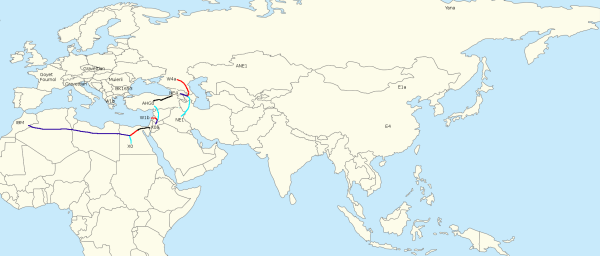

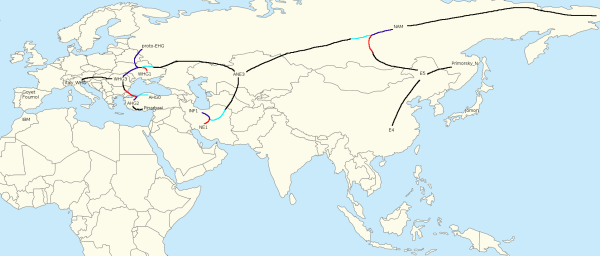
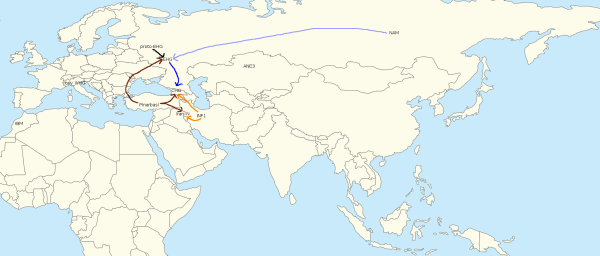
 Files.zip
Files.zip (Size: 215.8 KB / Downloads: 81)
Posts: 321
Threads: 8
Joined: Oct 2023
Country: 
QpWave/ qpgraph will create almost a random graph, depending on the individuals included as selection. So it is not reliable. It takes lot of time for the calculations . In general it create artificial points (missing individuals) and trying to approximate the origin based on the real individuals + the artifically created individuals. On this base it will calculate the shortest path between the groups or the tree of origin. The advantage of this product: it allows to have many branches and it allows these branches to interconnect each other. However due to the complexity of the data, it may show the same data in one or another way.. So you may also check several options: the best results or you may check other possible solutions with not the best results. And the picture may differ drasticly between them.
Posts: 276
Threads: 2
Joined: Sep 2023
Country: 
10-19-2023, 12:33 AM
(This post was last modified: 10-19-2023, 12:33 AM by Kale.)
Yes I've had very little success with automated qpgraph when it comes to complex graphs. It's a case where to improve a complex phylogeny, a multitude of changes need to be made simultaneously, and that is incalculably improbable that it would stumble across all of them at once, so it never figures it out. Automated is good for testing simple things, but for big graphs, I always do it by hand.
Qrts and TanTin like this post
Posts: 10
Threads: 0
Joined: Oct 2023
East Eurasia 0 and West Eurasia 0 splitting in Europe is pretty ridiculous. Cant take rest of that E0 expanding from Europe and splitting in northern Iran into 1/1a/2/3 seriously.
Realistically, Western branches split in Anatolia-West Asia-Cacuasus and diversified. Most Eastern branches split in East Asia and Southeast Asia and diversified.
Psynome and Qrts like this post
Posts: 153
Threads: 0
Joined: Oct 2023
Gender: Undisclosed
10-19-2023, 07:45 AM
(This post was last modified: 10-19-2023, 07:47 AM by PopGenist82.)
Good effort I’d be interested to take a look
Yeah auto qp-graph doesn’t work too well, although I know some comedians in the past tried to claim it’s the same “because personality X, Y or Z said so”
Posts: 43
Threads: 1
Joined: Oct 2023
My advice would be to start with only the pre 40kya and work your way up, adding one at a time according to its date.
Posts: 118
Threads: 0
Joined: Oct 2023
Country: 
10-19-2023, 03:43 PM
(This post was last modified: 10-19-2023, 03:46 PM by old europe.)
(10-18-2023, 11:13 PM)Kale Wrote: Howdy all,
Figured I'd dig in and do some work for my first thread on the new forum. Hopefully this stimulates some discussion.
I'd really like to hear the opinions of those more well versed in paleolithic archaeology than myself (so pretty much everyone).
The product of my endeavor is a rather monstrous qpgraph, including 24 populations...
Mbuti
ZlatyKun
Ust_Ishim
BachoKiro_IUP
China_UP (Tianyuan & AR33k)
Onge_Jarawa (modern Onge, modern Jarawa, and Andaman_100BP)
Jomon
RUS_Primorsky_N (DevilsCave & Boisman)
Goyet_Fournol (GoyetQ116_1 & FRL006)
Yana
MA1
Muierii1
Kostenki14
Sunghir
BachoKiro_BK1653
Gravettian (KremsWA, Vestonice, Paglicci, Ostuni)
Peru_RioUncallane_1800BP
Georgia_UP (NEO283 & Dzudzuana)
Italy_WHG (GrottaContinenza, AreneCandide, San Teodoro, Oriente, Grotta del Uzzo 5054)
Pinarbasi
IBM (Taforalt & Morocco_Epipaleolithic OUB002)
Iran_N (GanjDareh, Wezmeh, TepeAbdulHosein)
EHG (Arkhangelsk, Sidelkino, and the early Minino individuals)
CHG
Attached to this post you should find a zip file containing
- Graph.SVG, open that in your browser to view the graph
- Dotfile and edgelist for the qgraph
- A text document and excel sheet that both contain the same information regarding residual stats
- Normal.PNG, a plot showing the distribution of the residuals and testing that distribution for normality (it appears to pass, which coupled with the worst F3 residual being z = 2.01, supposes to me all affinities are adequately accounted for)
To try and summarize the important and/or unexpected takeaways...
The first X node represents Neanderthal ancestry (for BachoKiro_IUP) and Neanderthal and/or damage in BachoKiro_BK1653
ZlatyKun = branches in between basal Eurasians and crown Eurasians, a dead end or a direct ancestor of crown Eurasians?
Goyet_Fournol = a mix of Ust-Ishim and something occupying a similar position to BachoKiro_IUP
'Kostenki-cluster' = a mix of Goyet related ancestry and basal.
ANE = Kostenki-cluster + a generic sort of East-Eurasian (Yana has some Tianyuan on top)
East-Asians (Jomon/Primorsky) = Onge-related lineage + Tianyuan
Near-East = after mixing into the Kostenki-cluster, Basal becomes mixed with the Onge-related lineage that contributes to East-Asians
Georgia_UP = a mixture of the above BE/East-Asian mix and Muierii1
Pinbarbasi = Georgia_UP-like but with 10% WHG
Iran_N = baseline is BE/East-Asian mix, with some ANE and Pinarbasi
CHG = Iran_N but with more Pinarbasi and some EHG
Taforalt = a mix of ANA, proto-Pinarbasi (before the WHG), and 'Levantine Aurignacian', a Goyet-related population that presumably passed through SE Europe 'Balkan Arignacian?', and that also proves crucial in BK1653 and WHG. I do remember reading about a late surivial of Aurignacian technology in Greece, maybe that is related.
WHG = Gravettian + 'Balkan-Aurignacian' + Georgia_UP + ANE
EHG = WHG + Pinarbasi + para-Native-American (UKY, Kolyma, etc.)
Note that in especially the real early branching and in East Eurasians, where we have so few samples, there are multiple phylogenies that work, I just picked the one that made most sense to me.
The following 7 images attempt to illustrate on a map, and through time, what is happening on the graph. Black lines more or less represent regular branching and drift, red and blue lines indicate admixture sources, purple lines indicate the post-admix population. Green lines indicate drift not occuring over distance, but over time - a period of geographic standstill which drift occurred. The colors on the 15kbp slide don't mean much, I got tired and just drew arrows because there are 3 way mixes going on.
The 7 time periods are roughly, 1) pre-40k, 2) post-CI Eruption, 3) 35kbp, 4) 30kbp, 5) LGM-onset, 6) post-LGM, 7) 15kbp
Excellent work. Two questions
In your view the proportions of west eurasian/ east eurasian in the ANE/ANS cluster are the same as many other models id est 75% west and 25% east or did you find sometning different?
Which are the proportions of Basal and Kostenki in the Near East cluster?
Posts: 118
Threads: 0
Joined: Oct 2023
Country: 
Ok I have seen your model on the zip file.
Posts: 153
Threads: 0
Joined: Oct 2023
Gender: Undisclosed
10-19-2023, 11:28 PM
(This post was last modified: 10-20-2023, 02:33 AM by PopGenist82.)
(10-19-2023, 02:18 PM)Chad Wrote: My advice would be to start with only the pre 40kya and work your way up, adding one at a time according to its date.
Working up step-by-step in chronological manner isn't exactly a methdological novelty.
Any more clarifications on your odd claims Caucasus MUP have no relation to later west asians ?
Posts: 16
Threads: 3
Joined: Oct 2023
Gender: Male
Nationality: American
Y-DNA (P): R-U106
Country: 
Okay, I have a few questions:
1) What is "Para-Native-American" in this context? Is it Native American? Or is it the ANE-like component of Native American? I don't see how EHG could be modeled with no ANE but with some sort of Siberian component? I have always heard EHG described as if it is a fine combination of Villabruna and ANE. Where Pinarbasi comes from especially in this equation, I do not understand...
2) I don't understand why you are saying HG groups like KS-Clade, WHG, and EHG have Basal components in them. Isn't the whole idea behind Basal to explain a difference between these groups and the basal-rich groups themselves?
3) How much distinction is there between BK IUP and Tianyuan? It seems to be like BK and Tianyuan are both very early East Eurasians. But some other people say they're Crown Eurasians. Doesn't Goyet have a stronger association with Tianyuan than ANE? Could, perhaps, the East-shift of IRN_N be also explained by BK-like ancestry?
Also, what of Natufians?
Me personally, I think we just need more MENA samples before ever hoping at getting to the bottom of this.
Posts: 153
Threads: 0
Joined: Oct 2023
Gender: Undisclosed
10-20-2023, 12:31 AM
(This post was last modified: 10-20-2023, 02:31 AM by PopGenist82.)
(10-18-2023, 11:13 PM)Kale Wrote: Howdy all,
Figured I'd dig in and do some work for my first thread on the new forum. Hopefully this stimulates some discussion.
I'd really like to hear the opinions of those more well versed in paleolithic archaeology than myself (so pretty much everyone).
Initial impression - I agree with overall Typology. From my experience, Ust-Ishim can shift its behaviour, Im not sure its the next to branch off after ZK. Seems to be more consistently within the BK- ENA clade.
Im not sure about a basal ENA into WHG. Timing, Y-DNA and archaeology supports something ANE like MA-1
Agree with Dzudzuana-Pinarbasi like input into EHG
I like how you do not use irrelevant labels such as 'Crown Eurasian', etc
Probably more details to discuss.
Generally, for fine-grained admixture details, qpADM is more applicable.
Posts: 19
Threads: 0
Joined: Oct 2023
Somewhat tangential, but does anyone recall what all the Y-calls were for the different Bacho-Kiro samples? I remember one user on Anthrogenica claimed that one of them was apparently P*, but I'm not sure if that was ever validated?
Posts: 276
Threads: 2
Joined: Sep 2023
Country: 
10-20-2023, 02:44 AM
(This post was last modified: 10-20-2023, 03:36 AM by Kale.)
(10-19-2023, 05:42 AM)Song Wrote: East Eurasia 0 and West Eurasia 0 splitting in Europe is pretty ridiculous. Cant take rest of that E0 expanding from Europe and splitting in northern Iran into 1/1a/2/3 seriously.
Realistically, Western branches split in Anatolia-West Asia-Cacuasus and diversified. Most Eastern branches split in East Asia and Southeast Asia and diversified.
If you'd like to sketch out that idea I'll run it.
(10-19-2023, 02:18 PM)Chad Wrote: My advice would be to start with only the pre 40kya and work your way up, adding one at a time according to its date.
Sound advice, that was my strategy, except started with a ~35kbp slate.
(10-19-2023, 11:43 PM)billh Wrote: Okay, I have a few questions:
1) What is "Para-Native-American" in this context? Is it Native American? Or is it the ANE-like component of Native American? I don't see how EHG could be modeled with no ANE but with some sort of Siberian component? I have always heard EHG described as if it is a fine combination of Villabruna and ANE. Where Pinarbasi comes from especially in this equation, I do not understand...
2) I don't understand why you are saying HG groups like KS-Clade, WHG, and EHG have Basal components in them. Isn't the whole idea behind Basal to explain a difference between these groups and the basal-rich groups themselves?
3) How much distinction is there between BK IUP and Tianyuan? It seems to be like BK and Tianyuan are both very early East Eurasians. But some other people say they're Crown Eurasians. Doesn't Goyet have a stronger association with Tianyuan than ANE? Could, perhaps, the East-shift of IRN_N be also explained by BK-like ancestry?
Also, what of Natufians?
Me personally, I think we just need more MENA samples before ever hoping at getting to the bottom of this.
1) I use the term 'para-American', to describe populations similar to (and probably from the same near source as) Native Americans: UKY, Kolyma_meso, etc. EHG have plenty of ANE, in this model they just receive an extra bit of para-American ancestry, probably associated with mt-C, and some y-hg Q lineages. In regards to Pinarbasi coming into the equation, IronGates have been featured in publications modeled with Anatolian ancestry, it's not so controversial anymore, and their incidences of mt-U8b, K1, and H13 support it. A number of EHG too have been found with mt-K1 and T2.
2) Basal was initially drafted to explain why Ust-Ishim was ~equally related to East Eurasians and to WHG, and less related to EEF and modern West Eurasians. But then we found GoyetQ116_1 and Fournol, who are even more related to Ust-Ishim than East-Eurasians or WHG.
Mbuti.DG Ust_Ishim.DG GoyetQ116_1 Italy_AreneCandide_HG -0.00216 -2.99 612812
Mbuti.DG Ust_Ishim.DG GoyetQ116_1 Villabruna -0.00158 -2.29 682237
Mbuti.DG Ust_Ishim.DG Gravettian_France_Fournol Italy_AreneCandide_HG -0.00187 -2.69 475638
Mbuti.DG Ust_Ishim.DG Gravettian_France_Fournol Villabruna -0.00133 -1.97 504516
3) BK is a very very early East Eurasian. Tianyuan is much more East Eurasian. In regards to Goyet <-> Tianyuan, the fuss is because Goyet is more related to Tianyuan relative to Kostenki, but relative to Kostenki, Goyet is also more related to Ust-Ishim and every other East-Eurasian
Mbuti.DG GoyetQ116_1 Ust_Ishim.DG Tianyuan 0.00122 1.47 678855
Mbuti.DG Gravettian_France_Fournol Ust_Ishim.DG Tianyuan 0.00106 1.38 501912
You don't have to be terribly conservative to chalk that up to 1240k bias.
I didn't add Natufians because of their low coverage.
(10-20-2023, 12:31 AM)PopGenist82 Wrote: Initial impression - I agree with overall Typology. From my experience, Ust-Ishim can shift its behaviour, Im not sure its the next to branch off after ZK. Seems to be more consistently within the BK- ENA clade.
Im not sure about a basal ENA into WHG. Timing, Y-DNA and archaeology supports something ANE like MA-1
Agree with Dzudzuana-Pinarbasi like input into EHG
I like how you do not use irrelevant labels such as 'Crown Eurasian', etc
Probably more details to discuss.
Generally, for fine-grained admixture details, qpADM is more applicable.
WHG doesn't get any direct ENA mixture in the graph. It gets some associated with ANE, and the rest gets mediated by Georgia_UP, which I assume would be associated with y-hg K1/H2. In regards to WHG's uniparental markers, they are a very bottlenecked group as is well known, and lost much of the diversity that was present even amongst Gravettians (mt-U2, U5, U8c, M)
(10-20-2023, 02:43 AM)Horatio McCallister Wrote: Somewhat tangential, but does anyone recall what all the Y-calls were for the different Bacho-Kiro samples? I remember one user on Anthrogenica claimed that one of them was apparently P*, but I'm not sure if that was ever validated? One was pre-F2'4. Two more were C/C1 IIRC
The P* was validated as a female 
Posts: 153
Threads: 0
Joined: Oct 2023
Gender: Undisclosed
10-20-2023, 04:16 AM
(This post was last modified: 10-20-2023, 04:22 AM by PopGenist82.)
(10-20-2023, 02:44 AM)Kale Wrote: [quote pid="1774" dateline="1697694167"]
WHG doesn't get any direct ENA mixture in the graph. It gets some associated with ANE, and the rest gets mediated by Georgia_UP, which I assume would be associated with y-hg K1/H2. In regards to WHG's uniparental markers, they are a very bottlenecked group as is well known, and lost much of the diversity that was present even amongst Gravettians (mt-U2, U5, U8c, M)
Yep so it does.
Do you still avoid using Afontova Gora- 3 ? Its coverage is not too horrid
Quote: Also, what of Natufians?
IMO as a broad picture
left pops:
Israel_Natufian_d
GEO_Dzudzuana_UP
Morocco_Iberomaurusian
right pops:
Cameroon_SMA
China_Tianyuan
Russia_MA1_HG.SG
Czech_Vestonice
Belgium_UP_GoyetQ116_1
Russia_Sunghir1.SG
Laos_Hoabinhian.SG
Italy_North_Villabruna_HG
Turkey_Epipaleolithic
Russia_AfontovaGora3
Indian_GreatAndaman_100BP.SG
Ethiopia_4500BP
best coefficients: 0.756 0.244
totmean: 0.756 0.244
boot mean: 0.757 0.243
std. errors: 0.042 0.042
Tail prob 0.06
Posts: 153
Threads: 0
Joined: Oct 2023
Gender: Undisclosed
What was the Z-valuen for your graph ?
I'm unconvinced about a separate, pre-ZK "Basal" clade.
|







 Files.zip (Size: 215.8 KB / Downloads: 81)
Files.zip (Size: 215.8 KB / Downloads: 81)
 Files.zip (Size: 215.8 KB / Downloads: 81)
Files.zip (Size: 215.8 KB / Downloads: 81)









